
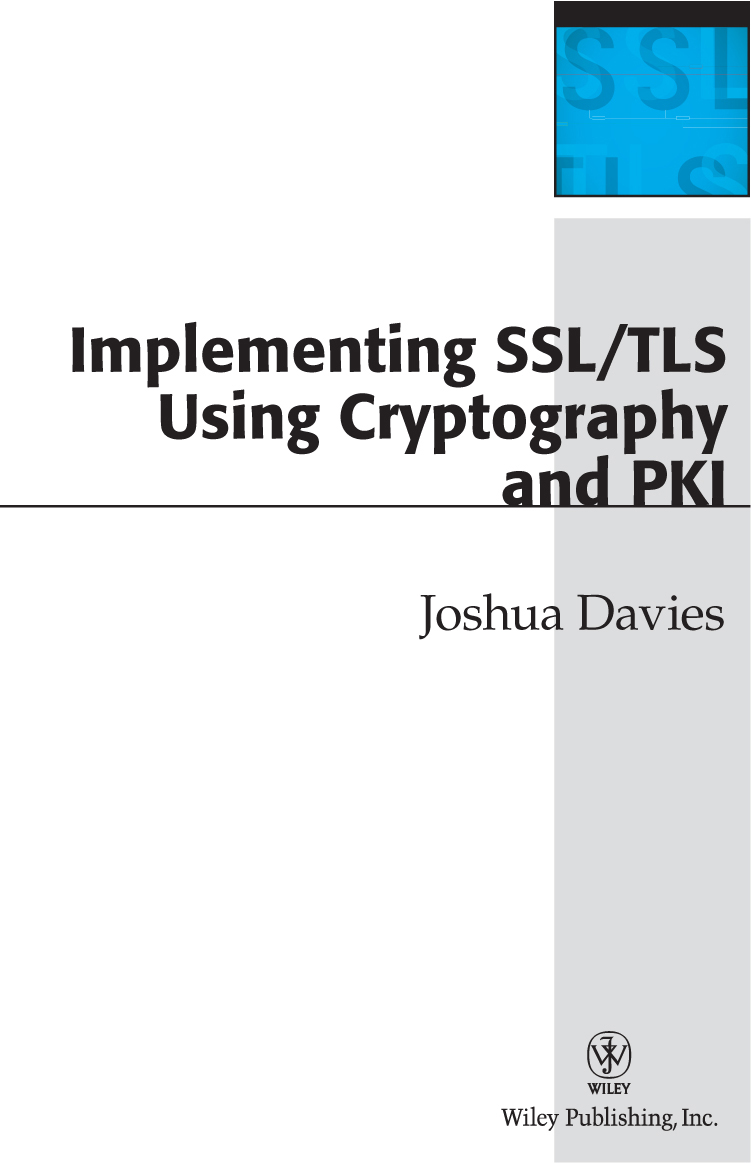
Implementing SSL/TLS Using Cryptography and PKI Published by Wiley Publishing, Inc. 10475 Crosspoint Boulevard Indianapolis, IN 46256 www.wiley.com Copyright 2011 by Wiley Publishing, Inc., Indianapolis, Indiana Published simultaneously in Canada ISBN: 978-0-470-92041-1 ISBN: 978-1-118-03875-8 (ebk) ISBN: 978-1-118-03876-5 (ebk) ISBN: 978-1-118-03877-2 (ebk) No part of this publication may be reproduced, stored in a retrieval system or transmitted in any form or by any means, electronic, me-chanical, photocopying, recording, scanning or otherwise, except as permitted under Sections 107 or 108 of the 1976 United States Copyright Act, without either the prior written permission of the Publisher, or authorization through payment of the appropriate per-copy fee to the Copyright Clearance Center, 222 Rosewood Drive, Danvers, MA 01923, (978) 750-8400, fax (978) 646-8600. Re-quests to the Publisher for permission should be addressed to the Permissions Department, John Wiley & Sons, Inc., 111 River Street, Hoboken, NJ 07030, (201) 748-6011, fax (201) 748-6008, or online at http://www.wiley.com/go/permissions. Limit of Liability/Disclaimer of Warranty: The publisher and the author make no representations or warranties with respect to the accuracy or completeness of the contents of this work and spe-cifically disclaim all warranties, including without limitation war-ranties of fitness for a particular purpose. No warranty may be cre-ated or extended by sales or promotional materials. The advice and strategies contained herein may not be suitable for every situation.
This work is sold with the understanding that the publisher is not engaged in rendering legal, accounting, or other professional ser-vices. If professional assistance is required, the services of a com-petent professional person should be sought. Neither the publisher nor the author shall be liable for damages arising herefrom. The fact that an organization or Web site is referred to in this work as a citation and/or a potential source of further information does not mean that the author or the publisher endorses the information the organization or website may provide or recommendations it may make. Further, readers should be aware that Internet websites listed in this work may have changed or disappeared between when this work was written and when it is read. For general information on our other products and services please contact our Customer Care Department within the United States at (877) 762-2974, outside the United States at (317) 572-3993 or fax (317) 572-4002.
Wiley also publishes its books in a variety of electronic formats. Some content that appears in print may not be available in elec-tronic books. Library of Congress Control Number: 2010942196 Trademarks: Wiley and the Wiley logo are trademarks or regis-tered trademarks of John Wiley & Sons, Inc. and/or its affiliates, in the United States and other countries, and may not be used without written permission. All other trademarks are the property of their respective owners. is not associated with any product or vendor mentioned in this book. is not associated with any product or vendor mentioned in this book.
Statements of Copyright: This book refers to and incorporates portions of the Internet Engineering Task Force (IETF's) Request For Comments (RFCs). All RFC are protected by the following copyright. Copyright (C) The Internet Society (1999). All Rights Reserved. This document and translations of it may be copied and furnished to others, and derivative works that comment on or otherwise ex-plain it or assist in its implementation may be prepared, copied, published and distributed, in whole or in part, without restriction of any kind, provided that the above copyright notice and this para-graph are included on all such copies and derivative works. How-ever, this document itself may not be modified in any way, such as by removing the copyright notice or references to the Internet So-ciety or other Internet organizations, except as needed for the pur-pose of developing Internet standards in which case the procedures for copyrights defined in the Internet Standards process must be followed, or as required to translate it into languages other than English.
The limited permissions granted above are perpetual and will not be revoked by the Internet Society or its successors or as-signs. This document and the information contained herein is pro-vided on an "AS IS" basis and THE INTERNET SOCIETY AND THE INTERNET ENGINEERING TASK FORCE DISCLAIMS ALL WARRANTIES, EXPRESS OR IMPLIED, INCLUDING BUT NOT LIMITED TO ANY WARRANTY THAT THE USE OF THE INFORMATION HEREIN WILL NOT INFRINGE ANY RIGHTS OR ANY IMPLIED WARRANTIES OF MER-CHANTABILITY OR FITNESS FOR A PARTICULAR PUR-POSE. This book incorporates several examples making use of the OpenSSL software suite. OpenSSL is trademarked and copy-righted. OpenSSL is based on the excellent SSLeay library devel-oped by Eric A. Hudson. Hudson.
The OpenSSL toolkit is licensed under an Apache-style licence which basically means that you are free to get and use it for commercial and non-commercial purposes. This book describes in some detail several open standards main-tained and owned by FIPS, the ITU, PKCS, and SECG. The main-tainers and authors of these standards documents are attributed throughout the text. Verisign is used as an example of a Certificate Authority in Chapters 3 and 4. VeriSign and other trademarks are the registered or unregistered trademarks of VeriSign, Inc. and its subsidiaries.
For my wife, Lupita, who may not always understand but always accepts, supports, and encourages. About the Author  Joshua Davies has been hacking on computers since his father brought home the family's first computer, a TI-99/4A, in 1982. He holds a Bachelor's degree in computer science from Valdosta State University and a Masters degree in computer science from the University of Texas at Arlington. He has been programming professionally since 1990 and as a result has never had to do any real work. He is currently responsible for security architecture at Travelocity.com and previously worked internationally as a consultant for One, Inc. whose client list included AT&T, Nieman Marcus, Intermedia, and the Mexican telecommunications giant Pegaso.
Joshua Davies has been hacking on computers since his father brought home the family's first computer, a TI-99/4A, in 1982. He holds a Bachelor's degree in computer science from Valdosta State University and a Masters degree in computer science from the University of Texas at Arlington. He has been programming professionally since 1990 and as a result has never had to do any real work. He is currently responsible for security architecture at Travelocity.com and previously worked internationally as a consultant for One, Inc. whose client list included AT&T, Nieman Marcus, Intermedia, and the Mexican telecommunications giant Pegaso.
He prefers to work in C or assembler, but often codes in Java since it pays the bills. He currently resides in Dallas, Texas with his wife and two children. About the Technical Editor David Chapa is a Senior Analyst with the Enterprise Strategy Group covering the Data Protection segment with a focus on Disaster Recovery, Backup/Recovery as a Service, and Availability Solutions. David has invested over 25 years in the computer industry, focusing specifically on data protection, data disaster recovery, and business resumption practices. He has held several senior level technical positions with companies such as Cheyenne Software, OpenVision, ADIC, Quantum, and NetApp. Prior to joining ESG, as Director of Data Protection Strategy and Global Alliances for NetApp, David continued to evangelize Recovery and Backup, his mantra for over a decade now, and the benefits of integrating software solutions with disk-based backup.
In his role with ESG, David will bring all of this expertise, knowledge, and passion to raise a greater holistic awareness around data protection. David is an energetic and dynamic speaker who brings a great deal of experiential knowledge, humor, and keen insight to his audience. He has been a featured speaker at VERITAS Vision, CA World, SNW, Chicago Software Association, and CAMP/IT Conferences, and has served as panelist on various discussions related to disaster recovery, compliance, and the use of disk, tape, and cloud for recovery and backup strategies. David has written several articles and blogs over the years. In addition, he is the co-author of Implementing Backup and Recovery , the Technical Editor of Cloud Security , Security 2020 , and Web Commerce Security Design and Development with Wiley and Sons, and is recognized worldwide as an authority on the subject of backup and recovery. David is also a member of SNIA's Data Protection and Capacity Optimization (DPCO) Committee, whose mission is to foster the growth and success of the storage market in the areas of data protection and capacity optimization technologies.

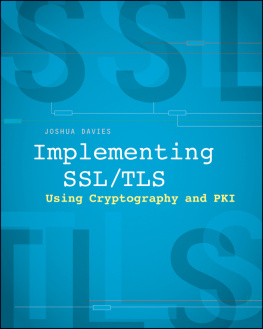

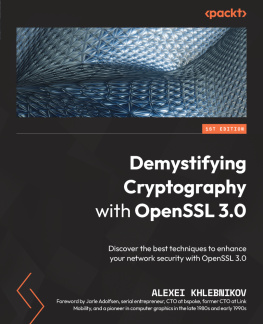
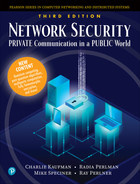


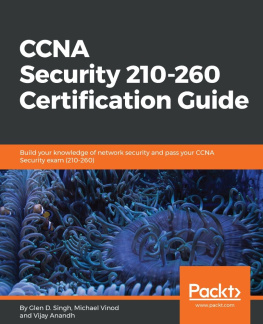
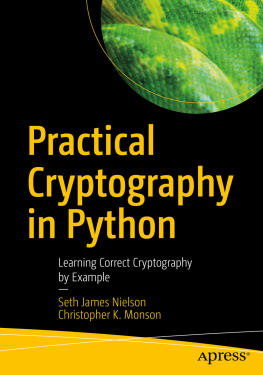





 Joshua Davies has been hacking on computers since his father brought home the family's first computer, a TI-99/4A, in 1982. He holds a Bachelor's degree in computer science from Valdosta State University and a Masters degree in computer science from the University of Texas at Arlington. He has been programming professionally since 1990 and as a result has never had to do any real work. He is currently responsible for security architecture at Travelocity.com and previously worked internationally as a consultant for One, Inc. whose client list included AT&T, Nieman Marcus, Intermedia, and the Mexican telecommunications giant Pegaso.
Joshua Davies has been hacking on computers since his father brought home the family's first computer, a TI-99/4A, in 1982. He holds a Bachelor's degree in computer science from Valdosta State University and a Masters degree in computer science from the University of Texas at Arlington. He has been programming professionally since 1990 and as a result has never had to do any real work. He is currently responsible for security architecture at Travelocity.com and previously worked internationally as a consultant for One, Inc. whose client list included AT&T, Nieman Marcus, Intermedia, and the Mexican telecommunications giant Pegaso.